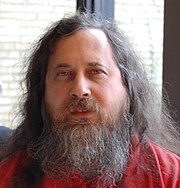
In the 1950s, 1960s, and 1970s, it was normal for computer users to have the freedoms that are provided by free software.
Software was commonly shared by individuals who used computers and by hardware manufacturers who were glad that people were making software that made their hardware useful. In the 1970s and early 1980s, the software industry began using technical measures (such as only distributing binary copies of computer programs) to prevent computer users from being able to study and modify software. In 1980 copyright law was extended to computer programs.
In 1983, Richard Stallman, longtime member of the hacker community at the MIT Artificial Intelligence Laboratory, announced the GNU project, saying that he had become frustrated with the effects of the change in culture of the computer industry and its users. Software development for the GNU operating system began in January 1984, and the Free Software Foundation (FSF) was founded in October 1985. He developed a free software definition and the concept of "copyleft", designed to ensure software freedom for all.
Free software is a widespread international concept, producing software used by individuals, large organizations, and governmental administrations. Free software has a very high market penetration in server-side Internet applications such as the Apache web server, MySQL database, and PHP scripting language. Completely free computing environments are available as large packages of basic system software, such as the many GNU/Linux distributions and FreeBSD. Free software developers have also created free versions of almost all commonly used desktop applications, including Web browsers, office productivity suites, and multimedia players. It is important to note, however, that in many categories, free software for individual workstations or home users has only a fraction of the market share of its proprietary competitors. Most free software is distributed online without charge, or off-line at the marginal cost of distribution, but this pricing model is not required, and people may sell copies of free software programs for any price.
The economic viability of free software has been recognised by large corporations such as IBM, Red Hat, and Sun Microsystems. Many companies whose core business is not in the IT sector choose free software for their Internet information and sales sites, due to the lower initial capital investment and ability to freely customize the application packages. Also, some non-software industries are beginning to use techniques similar to those used in free software development for their research and development process; scientists, for example, are looking towards more open development processes, and hardware such as microchips are beginning to be developed with specifications released under copyleft licenses (see the OpenCores project, for instance). Creative Commons and the free culture movement have also been largely influenced by the free software movement.



 LibreOffice
LibreOffice Firefox
Firefox
No comments:
Post a Comment